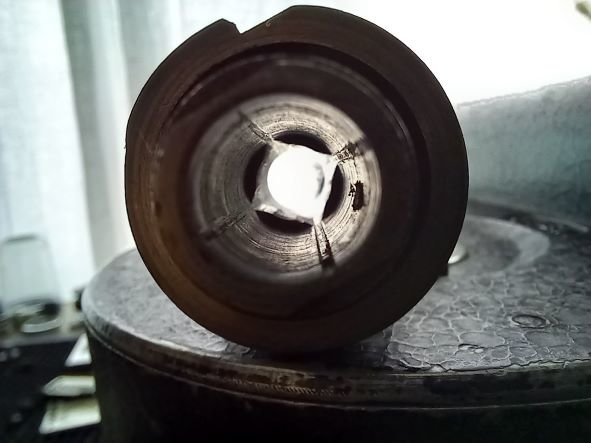-
Posts
2,587 -
Joined
-
Last visited
Everything posted by Simon Wyss
-
I have learnt that the mounting of the sideways acting prism consists of cork wedges. After so and so many years there’s chance that the prism comes loose a little. Not that focusing will become uncertain but you get an oblique view of the ground surface. A very good investment will be a new 13× enlarging eyepiece like it is built into the still manufactured Bolex SBM and EL cameras. Ask Bolex.
-
The 16-mm. film camera that really keeps speed amazingly constant is the Eumig C 16. This is so because of its gears and ball bearings for main and governor shaft. A maintained Eumig C 16 will not let you down. Mechanics as good as with Paillard-Bolex. The most compact and slimmest of all 16-mm. film cameras
-

Do you like technical stuff or emotional stuff?
Simon Wyss replied to George Ebersole's topic in General Discussion
I’d like to state that technical work is as creative as the so-called creative. Any division of human work into higher and only “mechanical” labour is as obsolete as Karl Marx was a fool. I think it’s about time everybody gets acquainted with this small fraction of humanism, that we are in-divi-duals. How could a 2nd camera assistant be happy in life or a copyist in the darkroom having the consciousness of being a donkey? Can I convey to you how satisfied I can be with having some dozen takes put into synch? I find it also rewarding to hear a positive opinion about some lighting I’ve done. Most of it was muscles and black hands. -
Read this: http://www.fdtimes.com/articles/Rune_Ericson/Super16Story.html
-
Depends on the camera motor control alone. The motor must have its power supply at a certain alternate current frequency such as 60 Hertz or 50 or an exactly pulsed direct current in the case of a commutation (brushless) motor or the control signal frequency, respectively. Sometimes the camera has to be or can be enough distant from the scene so that direct sound is possible. A Bolex can be quieted fairly well by having its gears lapped in, rubber insulation put in, and a barney wrapped around. Of course, the EBM and EL are less noisy than the H. Bolex 16 Pro is also rather quiet. Forget pilotone. Frequency from a crystal is so much better as a concept that I’m tempted to say by light years. Perhaps a clever head may provide you with the little software it takes to pull a given frequency from a laptop or even a cell phone, but that’s where my electronic knowledge finds a border. Only this added: deviation must not exceed half a frame over 16,000 frames which is the 400-ft roll. Head or tail clap, synch you have.
-
Fellows Here is some knowledge of the Austrian 1956 product. Opening angle in black plastic shutter: 160 degrees Rigidly controlled pulldown claw from the front according to ISO 69, leaving film at +3 position Lateral film guide by spring blade at optical axis height Main shaft bearing claw cam and shutter as well as governor shaft in miniature ball bearings, these under spring blades Main shaft steel worm, driving worm gear plastic; grease Three-blade centrifugal governor, horizontally arranged, leather-covered braking disk against steel arm If one is to clean and relube the mechanism one has to totally disassemble the camera. No bearing can be lubricated from outside. Brass gears, not ground The 25mm 1.9 lens has a ten blade double iris diaphragm. Hope this will help somewhere sometime.
-
Oh, no, I stopped after three seconds.
-
It does mean that. You are welcome. Which direction are you taking in cinematography?
-

5369 Kodak Panchromatic film stock
Simon Wyss replied to Guillaume Vallee's topic in Film Stocks & Processing
Google, type Kodak 5369, and you have http://motion.kodak.com/motion/uploadedFiles/US_plugins_acrobat_en_motion_products_lab_5369.pdf D-97 is positive process. -
Question was if EKC will survive, wasn’t it? More acutely, if motion-picture film will continue to be manufactured I have the impression that Aaton, Arri, Bolex, Ikonoskop, and Panavision people know more than us. To them, obviously, film seems to be an institution.
-
You should not run the camera at over 32 f. p. s. without film. Then you wind her fully, set the speed dial at 12 f. p. s., hold the camera upside down and listen to her running without film. When there’s rattle don’t use the camera before an overhaul. Probably never serviced the bearings are dry. The clicks can be switched off by the little lever just above the footage counter engagement pin at the inside rear. Have a look through the viewfinder with no lens in front of the taking port towards the sky or a uniformly lit surface. Adjust the eyepiece to maximum sharpness of the groundglass. Then swing back a lens into taking position, open iris diaphragm wide open, set lens at infinity and see whether distant objects such as trees or horizon come sharp. Everything must be clean. Film side guide (spring) must touch film and exert some pressure. One can check this function with a piece of film moved up and down by hand. Make sure the claw is withdrawn! For that you disengage the spring motor from the mechanism by turning the 180-degrees lever on the camera’s right side to 0 (Zero). If it doesn’t want to go, push the release simultaneously. With the rewind crank you can move the mechanism freely and fine set the claw forward and backwards.
-
I’m copy-pasting from Aaton’s web page: With its "distant-eye viewfinder" A-Minima invites the operator to move the camera from eyebrow to arm's length (and back), without worrying about the light that enters the eyepiece! This distant-eye feature is obtained by means of a cone-shaped shutter attached to the reflex mirror (Aaton patent): it prevents the light that enters the eyepiece from being diffused onto the film by the viewing screen. This feature is especially helpful to camera operators who wear glasses, or who take shots in acrobatic positions (e.g. mountaineering). (Coloured by me)
-

Can Film Actually Capture the Color Violet
Simon Wyss replied to Peter Ellner's topic in Film Stocks & Processing
Let me try again. Violet is a colour outside RGB. If at all, only the blue-sensitive layer(s) of a color film stock will respond to it. No Red involved, no Green Upon processing, a color negative stock produces the complementary colour to any given one. The complementary colour of Violet is . . . ? It doesn’t exist. No subtractive color photographic system until today is made for Violet. Why? It’s not needed. We see Violet only faintly. It’s off the retina’s RGB sensorium, too. A color positive film would have to have an extra layer of Violet dye in order to let Violet appear on the screen. Things are simpler with black-and-white plates or film. These do react to Violet as far as the colour is transferred to them by the lens. Violet exists in nature, proven. Animals see Violet and Ultraviolet. The answer is thus: Yes, film can capture the colour Violet but that’s where it ends also. There has never been Violet on a cinema screen or a photo paper. Violet is not purple, nor lilac, nor pink. Purple is the blend of Red and Blue, exactly half-way. Violet contains no Red. -
Here’s precisely where you hit my point. It is my strong believe that there will come new generations, young folks who might be ten years old now plus minus, who’ll rediscover handicraft. I mean, those who are growing up with CGI today actually must turn their heads towards closer-to-oneself doing some day. Editing has much to do with a movie’s content, so as soon as there is a picture to be made come alive producers will want reel creatives. It’s what one finds against the resistance from the material. Upright or flatbed, of course, is a matter of taste. But nothing replaces the joy one can get by doing it by hand. To hasten up the editing of a movie is simply plain stupid, greedy, and overly male. Where’s the female side of us all today?
-

film stock and processing in Tokyo?
Simon Wyss replied to Richard Tuohy's topic in Film Stocks & Processing
Richard, have a look: http://www.imagica.com/e/company.html http://www.imagicawest.com/westcom/film/fil_pro.html -
Well roared, lion Synching picture and sound is as easy on a flatbed as on an upright editing machine. I have direct access to the magnetic head and can hover a band to and fro by will until I’ve got the impression that I want. A differential gear helps a lot when you have to search for some things that match like a “p” and closed lips or a sharp sound and a fork hitting a plate. Reel sound synch work is with photographic dailies picture and sound! I mean, if you want to delve into it.
-
I have. Makers of magnetic film are Pyral and FPC-Eastman-Kodak, see under Fullcoat.
-

TAPE: type you carry, colors, questions...
Simon Wyss replied to John Swanson's topic in Camera Assistant / DIT & Gear
As lab technician I like to find white cloth tape around cans containing exposed stock. Film type identification by can label, any additional information written on the white tape. Please don’t write or paste on the label. Let it be the way it is. Short ends in cans sealed with black tape. That’s logic to me. Original film manufacturer tape discarded -
Did you ask Bolex for H 8 spools? They might have another one or two in the drawer.
-
Entirely agree with you, Phil. I call it opportunism.
-

How Do Theater Projectors Work
Simon Wyss replied to Peter Ellner's topic in Lenses & Lens Accessories
Which theater projects with flicker? -
Perhaps because being married doesn’t have the same importance anymore? Only fooling A married print, the term comes from before WWII, is no more dead synch but only reproducable on a projector or similar device built for the sound-to-picture advance. As long as picture and sound are on separate films one can manipulate and adjust for synchronism in a theatre, in front of the telly, whatever. In spite of that, printers are able to jeopardise the concept, projectionists as well. Worst experience is what I am making today with TV. Sound comes before picture, and you never get more than cop-outs.
-
Reminds me that I wanted to offer my new perforator also in DS-8. Give me a hint if interested in DS-8 black-and-white stock anyone, for instance Gigabitfilm or Europan.
-
Nothing can be too professional. The more something is done professional, the less it will be noticed (at all). Weigh content with form. Form alone is not enough, content alone is not enough.
-
My recommendation is black and white.


